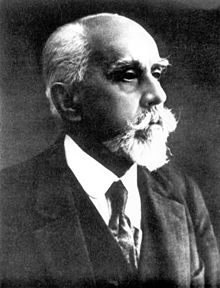Stefan Drzewiecki
| Stefan Drzewiecki | |
|---|---|

Stefan Drzewiecki
|
|
| Born | July 26, 1844 Kunka |
| Died |
April 23, 1938 (aged 93) Paris |
| Nationality | Polish |
| Occupation | Engineer, constructor and inventor |
| Known for | Submarine design |
Stefan Drzewiecki (July 26, 1844 in Kunka, Podolia, Russian Empire (today Ukraine, formerly Polish–Lithuanian Commonwealth) – April 23, 1938 in Paris) was a Polish scientist, journalist, engineer, constructor and inventor, working in France and the Russian Empire.
Drzewiecki was born into Polish aristocratic (szlachta) family of national patriots. His grandfather Józef Drzewiecki served under generals Kościuszko and Dąbrowski. His father Karol Drzewiecki took part in the November Uprising against Russia. Young Stefan was sent by him away from partitioned Poland to complete his education in France. At the beginning of 1860. Drzewiecki was admitted to L'Ecole Centrale des Arts et Manufactures, however he postponed finishing his engineering studies to take part in January Uprising (1863-1864) against Russia. A few years later, he came back to Paris to finish his study. With a knack for creativity and invention, Stefan Drzewiecki invented such useful tools as the kilometric counter for taxicabs. At the special request of Grand Duke Konstantin, Drzewiecki moved to Saint Petersburg in 1873 at the age of 29. While in Russia Drzewiecki had a fruitful career as a mechanical engineer.
Drzewiecki distinguished himself mainly in aviation and ship building. Beginning in 1877, during the Russo-Turkish War, he developed several models of propeller-driven submarines that evolved from single-person vessels to a four-man model. He developed the theory of gliding flight, developed a method for the manufacture of ship and plane propellers (1892), and presented a general theory for screw-propeller thrust (1920). He also developed several models of early submarines for the Russian Navy, and devised a torpedo-launching system for ships and submarines that bears his name, the Drzewiecki drop collar. He also made an instrument that drew the precise routes of ships onto a nautical chart.
...
Wikipedia
